Stacey O’Nea, CEO, Port Moresby Chamber of Commerce and Industry (POMCCI): Interview

Interview: Stacey O’Nea
How do you assess the relationship between the government and private sector bodies?
STACEY O’NEA: Through a collaborative partnership approach, POMCCI and other key bodies represent the private sector interfacing with the government through events, trade shows, meetings, dialogue and negotiations. The government’s participation in the various forums and investment summits hosted by industry bodies indicates an ongoing positive relationship.
The recent public-private consultations that resulted in the withdrawal of the Foreign Investment Regulatory Authority bill as well as the review and amendment of the Investment Promotion Act of 1992 demonstrate the effectiveness of this relationship. Another important regulatory measure was implemented in 2014 when Parliament passed the Public-Private Partnership Act. This framework is supported by the Medium-Term Development Plan 2018-22, which is indicative of the government’s commitment to enhancing its relationship with the private sector.
While the private sector is the engine of economic growth, it is the government that provides the enabling environment. Therefore, we would like to see structured and consistent dialogue with the government so that the stability of our relationship is not dependent upon the administration of the day. To this end, industry bodies are collaborating to present a unified private sector voice on matters of importance.
In what ways is the government providing support to small and medium-sized enterprises (SMEs)?
O’NEA: The government has shown its commitment to developing the SME sector by passing the SME Corporation Act of 2014. Another important measure was the launch of the SME Policy 2016, comprising the SME policy document and the SME Master Plan 2016-30. The objective of the policy is to support and grow the SME sector in order to create new employment opportunities, achieve sustainable economic growth outside of the resources sector, and facilitate the fair and equitable distribution of wealth through majority citizen ownership of corporations. The policy has set out several ambitious targets, such as growing the number of SMEs from 49,000 to 500,000, and expanding formal employment from 290,000 to 2m.
The National Research Institute, the Department of Commerce and Industry, and the SME Corporation have identified several constraints on growth that still need to be tackled, however, including access to credit, financial literacy and financial inclusion; access to business or commercial land; and the involvement of women, youth and disadvantaged groups in the economy. The SME Master Plan has created strategies to resolve these challenges by 2030, leading to a supportive enabling environment for SMEs in the key areas of entrepreneurial development, legislative framework, catalyst projects and infrastructure development.
What impact did hosting APEC 2018 have on Port Moresby’s investment attractiveness?
O’NEA: The development of modern infrastructure in Port Moresby leading up to APEC 2018 summit has transformed the city’s landscape. Upgraded road networks, the international convention centre, modern commercial office facilities and new five-star hotels have given Port Moresby the facelift it needed to be regarded as an attractive destination for meetings, incentives, conferences and events.
Furthermore, Papua New Guinea’s economy was showcased to the world when leaders and conglomerates attended APEC events. As a result, we are seeing growing interest in the development of bilateral relations as well as economic interest and visits to PNG from New Caledonia, Russia, New Zealand, Cuba, Brazil, Pakistan and the Netherlands, among many other countries. Nevertheless, in order to enhance our potential, progress in the areas of safety, security and affordable housing in Port Moresby must be realised.
You have reached the limit of premium articles you can view for free.
Choose from the options below to purchase print or digital editions of our Reports. You can also purchase a website subscription giving you unlimited access to all of our Reports online for 12 months.
If you have already purchased this Report or have a website subscription, please login to continue.

